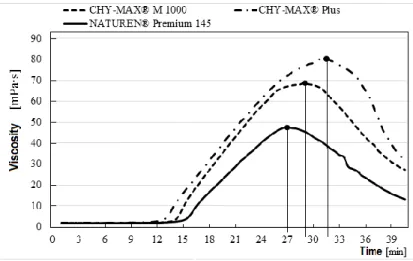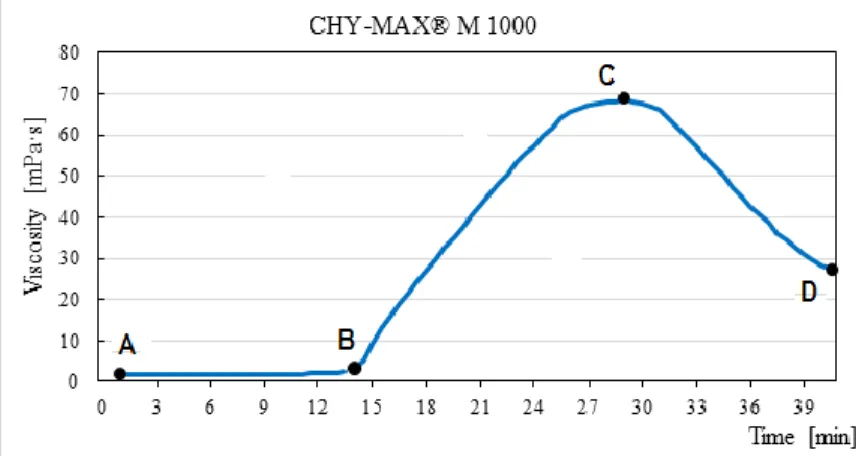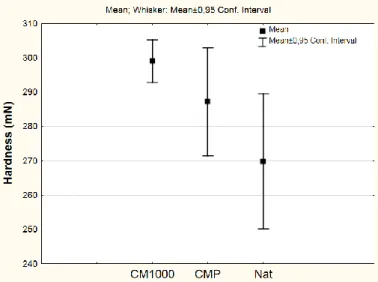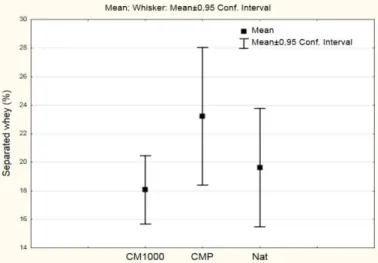EFFECT OF DIFFERENT COMMERCIAL ENZYMES ON THE CLOTTING OF MILK AND CERTAIN PROPERTIES OF CURD
József Csanádi,Ottilia Bara-Herczegh, Attila Szabolcsi, József Mihalkó, Ádám Lőrincz Department of Food Engineering Faculty of Engineering, University of Szeged 6725 Szeged, Moszkvai krt 6-7. Hungary
e-mail: csanadi@mk.u-szeged.hu
Received: February 10, 2021 • Accepted: March 4, 2021
ABSTRACT
More researches published data about the milk curd properties, evaluated the importance in the cheese making, but an analysis of importance of these properties in practical applications is usually lacking. We investigate the milk curd behaviour using different enzyme preparations at the cutting of curd. We focused on the well measurable properties as clotting time, viscosity of curd, texture properties and whey separation rate of cur at cutting time. Approximately five minutes difference was determined between the clotting times. Investigated the curd properties we found significant differences between the hardness on samples clotted with CHY MAX® M 1000 and NATUREN® Premium 145 enzymes. Other properties did not show significant differences, but in some case differences were remarkable.
Discovered differences e.g. approx. 5% whey separation rate difference and the different trends of adhesive force and adhesiveness confirm that such studies should be carried out. Summarized effect of different enzymes can alter the cheese making technology significantly in practice. Considering every aspect, in our investigation the CHY MAX® M 1000 enzyme seemed the best.
Keywords: clotting enzymes, curd properties, cheese making, curd loss, syneresis, 1. INTRODUCTION
In many cases, the fundament of cheese making is the clotting of milk by enzyme. The clotting is performed by different enzyme preparation for splitting kappa-casein causing aggregation of casein micelles leads to the formation of protein network. For the curd formation, removing required amount of liquid phase (whey) is essential by, taking advantage of syneresis.
Conditions of clotting and syneresis determine the clotting time, curd properties, syneresis rate, losses in whey, etc., so the optimization of clotting and the handling of curd is a well discusses area. The preliminary cold storage, the pasteurization, the fat content, ionic Ca++ content of milk, as the clotting temperature and amount of clotting enzyme have significant effect on clotting time and the texture of curd, e.g. on hardness [1], [2], [3].
After the clotting, syneresis becomes to determining factor in whey separation. It is affected by temperature, elapsed time, pH, rheological properties of the gel at cutting, curd surface area, proteolytic activity of enzyme and CaCl2 concentration [4], [5], [6], [7], [8].
Factors affecting syneresis rate and extent, including milk composition and pre-treatment, coagulation factors, rheological properties of the gel at cutting, curd surface area, external pressure, and curd temperature and pH, have been widely reviewed [4], [8], [5], [6], [7].
Many different empirical techniques have been published to study the kinetics of syneresis as reviewed by [8], [9]. First order kinetics has been reported by many authors to describe the rate of syneresis [4], [10], [11]. Preliminary techniques were developed for monitoring syneresis parallel with the moisture determination of curd, evaluated the changes of curd volume, and measuring the volume of separated whey from the curd [12], [4]. Some researcher worked using image analysis to monitor the curd shrinkage [13].
This was a very new type of non-destructive method, so it contained better information for practice. But we can say that because of the continuous changing of the structure of curd and the composition of curd during clotting and mainly during the curd handling, makes it very difficult to develop a good method for the
precise and accurate monitoring [14]. Indeed, the experimental conditions are often too distant from industrial practice to extrapolate results.
Ultimately, curd properties and syneresis can determine the most important aspects of cheese making as sensory properties of cheeses and losses during the processing. Therefore, in last decades some empirical or instrumental methods were investigated for monitoring the syneresis during the “in-vat” processes of cheese making [9], [10], [13], [15], [11], [16]. After clotting, the cutting of curd is the first essential treatment can alter the curd loss dramatically. Too soft curd at the cutting leads more curd losses (affecting the cheese yield), retarded syneresis can result weak or deficient cheese sensory properties. However, the producers attach valuable information about the working of enzyme preparations, but different products with same certificate clotting activity usually do not lead to the same clotting time, curd strength and syneresis rate. The effect of different enzyme preparations on the mentioned consequences is not discussed sufficiently.
Due to the mentioned aspects we investigated the curd properties at the time of cutting. Three different commercial enzyme preparations were used in this experiment. Gel strength (viscosity), clotting time, other measurable texture properties and water binding capacity of curds were investigated in our work.
2. MATERIALS AND METHODS 2.1. Pre-treatment of raw cow milk
Cold stored raw cow milk was used for every measurements. Milk was standardized to 3.50 % (m/m) fat content and protein content range was 3.25-3.31 % (m/m). Milk analysis was performed by using of Bentley 150 milk analyser (Chaska, Minnesota, USA) at 40°C. Milk was pasteurized at 72 C° with 1 minute holding in a jar using induction heater then was cooled at 32 C° for the clotting. After cooling 0.02% CaCl2 (with 30% solution) was added into cheese milk then it was agitated to ten minutes.
2.2 Enzymes
Three commercial enzyme preparations were used in this research. CHY-MAX® M 1000 (EC 3.4.23.4) pure chymosin produced by Aspergillus niger var. awamori, CHY-MAX® Plus: (EC 3.4.23.4), pure cattle chymosin (EC 3.4.23.4) produced by Aspergillus niger var. awamori and NATUREN® Premium 145 (EC 3.4.23.4) 83-88% calf chymosin and 12-17% cattle pepsin mixture. All enzymes were produced by Chr.
Hansen Denmark.
Table 1: Enzyme parameters given in the producers’ certificates
Enzyme preparation Offered dosage [IMCU L-1 milk]
Average activity [IMCU mL-1 enzyme]
CHY-MAX® M 1000 20-50 1000
CHY-MAX® Plus 30-60 1200
NATUREN® Premium 145 30-60 1145
20 % (m/m) solutions were made with distilled water from every enzyme preparation and the dosage for investigations was based on the arithmetic mean of the offered dosages. Clotting was performed in water bath (Memmert WNB-14, Schwabach, Germany). Investigations to determine the clotting time and peak viscosity value of the clotting curve were performed in two replicates. There was no enough data to calculate standard deviation.
2.3. Viscosity
Viscosity was measured with vibration viscometer (A&D SV-10, Japan). Data were fixed by using of the own software of instrument. Plastic cuvette was filled with 45 mL inoculated milk sample the sensor head of viscometer was immersed fully into the sample. Software fixed the temperature and viscosity of milk using 30 sec. sampling. The time-viscosity curves reached a peak in every case, and we considered the peak time as the cutting (clotting) time.
2.4. Texture investigation
Texture parameters were measured in five parallel samples in case of every enzyme preparations. After adding enzymes, samples were agitated for 1 minute, then were stored in water bath at 32°C for 30 minutes, thus the clotting was the same. Enzyme inoculations were performed with 10-minutes slides, thus giving enough time for the measure. Brookfield CT3 texture analyser was used for the investigation.
Parameters as follow: cycles: 1, test type: penetration, target value: 20 mm, trigger load: 40 mN, probe:
25.4 mm diameter plastic piston, test speed: 0.5 mm/s. Hardness, hardness work, adhesive force and adhesiveness were used for the evaluation. The explanation of used parameters is shown in Fig 1. Five parallel measures were performed from every sample.
Figure 1: Explanation of different texture parameters (Armero and Collar 1997)
2.5. Water binding capacity
Gravimetric method was use for the determination of water binding capacity of curds. Pre-treatment of milk was same as mentioned before. After the enzyme addition the weight of samples in 100 mL plastic centrifuge tubes was determined to four decimal places. Clotting times at 32°C was set considering the result coming from the viscosity measures (peak times of different samples). After the clotting we cut the curds to eight vertical parts and centrifuged the samples at 5000 rpm for 5 minutes in an MPW 350 (MPW Med. instruments Warsaw, Poland). Then whey was separated and weights were measured to for decimal places. Result was expressed in percentage of separated whey from curd. Five parallel sample were investigated from every sample.
3. RESULTS AND DISCUSSION 3.1. Viscosity – clotting time
The evolution of time-viscosity curves was very similar, but we explored differences in the maximum values of viscosity and time associated with them (Fig 2).
Figure 2: Viscosity development of curds clotted with different enzymes as a function of time (average of two replicates) Samples needed different time for reaching the peak of viscosity (considering as clotting time). We recorded approximately 5 minutes difference between samples clotted with Naturen and Chy-Max plus.
The question is whether we can consider this as important difference in the cheese making technology.
Well, five minutes difference, mainly after the reaching an appropriate curd texture, doesn’t seem important. The curd is hard enough, and there is no visible whey separation on the surface of curd. But considering the rate of syneresis after the clotting we can say, it can be. The rate of syneresis determines the speed of whey separation and thus, the residence time of curd in the cheese vat, during which fermentation takes place.
The optimal properties of cheeses depend on the complex physical and biological phenomena during cheese making so if the optimal balance changes, it can have a significant effect on the composition and sensory properties of cheeses. The fine structure of protein network formed during the clotting could modify the behaviour of curd and properties of cheeses.
Thus, we divided the time-viscosity curd to different stages, see Fig. 3.
Figure 3: Different stages of clotting in our investigation (A. Enzymes inoculation; AB: preliminary casein micelle aggregation;
B: at this moment the viscosity 75% higher than the initial one; B-C: clotting; C: cutting time of the curd considered at peak-time) We explored different time for preliminary micelle aggregation using different enzymes. Because of the degree of micelle aggregation can alter the size of aggregate particle this can lead different fine structure of protein network, altering the clotting time and behaviour of curd.
We explored that the time needed for the different clotting stages and the ratio of stages were different in case of clotting by different enzymes (Tab. 2).
Table 2: the time required for different stages of clotting and ratio of them (average of two replicetes)
Enzyme preparations AB [min]
BC [min]
AB/BC ratio
C [min]
AB/C ratio
CHY-MAX® Plus 12,0 18,5 165% 31,5 38%
CHY-MAX® M 1000 13,0 15,0 187% 29,0 45%
NATUREN® Premium 145 14,5 11,5 126% 27,0 54%
There was no remarkable difference in duration of micelle aggregation (AB) but likely the mentioned mechanism an activity difference of enzymes caused interesting variation in the time interval of milk gel formation period (BC). Data prove that the Naturen 145 enzyme (calf and cattle chimosyn mixture) caused the shortest “gelation” time while CHY-MAX Plus had the longest gelation period. It suggests that activity of biochemical reactions (as Ca bridges formation between micelles) modified by different enzyme types, can alter the cheese vat time and properties of curd.
3.2. Texture properties Hardness
Second important aspect is the hardness of curd at the cutting. If we cut the curd before the optimal status, it leads significant more curd fines in whey causing more protein losses, but if we cut it too late, the syneresis becomes retarded can lead too high acidity of curd. We recognized remarkable differences in curd viscosity at cutting time. Sample clotted by CHY-MAX plus had hardness (viscosity) of about twice
The harder curd is better for cheese making, limiting the curd loss, but only up to a limit by our opinion.
We recognized this difference with our naked eyes too. This variation can cause difference in the amount of curd fines in whey. These finding were interesting because of it is well known that the activity (concentration) and specific proteolytic ability of different enzymes coming from different origin (as chimosin, pepsin and microbial enzymes) have effect on the clotting time and sometimes on curd properties [2], [11], [3].
Figure 4: Curd hardness at cutting time (peak-time) as a function used clotting enzymes (CM1000: CHY MAX® M 1000; CMP:
CHY MAX® Plus ; Nat: NATUREN® Premium 145 )
But two enzymes used were produced by microorganisms. Furthermore clotting enzymes made from cattle or calf stomach usually have higher activity and better effect on the clotting. Whether there is a real, significant effect of a 5 min difference on the cheese making technology and on the properties cheeses made with the clotting by enzymes, requires further experiments.
Adhesive force
The adhesive force on the knives during cutting may be important because the higher force the higher ratio of curd fines can lead to more curd losses. Compared to those found for hardness, the adhesion force shows opposite trend for different enzymes, as shown in Fig. 5. Explored difference of means was not as high as in case hardness values.
Similarly, there was no significant difference in Adhesiveness values, although the means represented remarkable difference. It can be explained with the very wide confidential interval and high SD. We have to note that perhaps it would have been better to use another probe to determine the texture properties. The shape of probe may have been responsible for big difference between the values of parallel samples and for very high SD values.
Figure 5: Curd adhesive force and adhesiveness at cutting time (peak-time) as a function used clotting enzymes (CM1000: CHY MAX® M 1000; CMP: CHY MAX® Plus ; Nat: NATUREN® Premium 145)
These high values also pointed that the cheese curd is very sensitive against to mechanical treatments so cutting and handling of curd is essential considering the curd loss. The curd properties are essentials in this term but the cutting and mixer frame design, distance of cutting knives, the material quality and the optimal setting of tool’s speed are also very important for limiting the curd loss.
3.3 Water binding capacity
Water binding capacity of curd at cutting until the heating of curd basically determines the whey separation rate and the time requirement of “drying of curd”. During this time period, lower water binding capacity is advantageous for prevention of over-acidification of curd that can lead to too low pH of cheese, altering the required sensory properties. We used the offered optimal amount of enzymes and conditions for clotting, but surprisingly, we explored different whey separation rates (Fig. 6).
Figure 6: The degree of whey separation at cutting time as a function used clotting enzymes (CM1000: CHY MAX® M 1000;
CMP: CHY MAX® Plus ; Nat: NATUREN® Premium 145)
However, the differences were not significant, based on our method and measure, the difference of means were remarkable, by our opinion. In this examination CHY MAX® Plus enzyme had the highest and CHY MAX® M 1000 enzyme had the lowest whey separation rate. In other words, water binding capacity of sample clotted with CHY MAX® M 1000 was the most disadvantageous, considering the demand of fast whey separation.
4. CONCLUSIONS
Based on our method, the clotting time of milk samples using different enzymes showed differences. A five minute difference doesn't seem big, though it may be important considering the changes of curd properties and the behaviour of curd during the further cheese making steps.
All type of clotting enzyme was suitable for clotting of milk and to reach suitable curd properties. We did not determine extreme values during experiments. But, considering the deeper investigation of curd properties at cutting, we explored interesting differences cause by different clotting enzymes. Using the producer’s suggestions for clotting, CHY MAX® Plus presented the highest and NATUREN® Premium 145 the lowest curd viscosity at cutting. Furthermore, the degree of milk (or curd) solidification was the lowest in case of NATUREN® Premium 145 samples.
Using texture analyser, explored differences of data coming from clotting with NATUREN® Premium 145 were confirmed, and significant difference was determined between the hardness means of NATUREN®
Premium 145 and CHY MAX® M 1000 samples. In case of adhesive force and adhesiveness there were no significant differences, but we determined opposite trend between this two parameters, that is, greater adhesive force results in less adhesiveness. We also could not detect a significant difference in whey separation rate, but detected 4-5 percentage difference can lead significant time requirements in cheese vats to reach the optimal curd condition before removing it from vats for further curd handling.
Summarizing the explored differences we can say, these findings suggest that the behavior of curd may be different when different enzymes are used. At last, without the modification of technology and parameters, it can cause economical and product quality problems in cheese making.
REFERENCES
[1] Scott R., Robinson R. K., Wilbey R. A. (1998): Cheesemaking Practice Third edition, Springer Publishing Company, New York 161., 170.
[2] Walstra, P. Wouters, J.T.M.; Geurts, T.J. (2006): Dairy Science and Technology, Second Edition Boca Raton, FL, USA : CRC (Food science and technology 147) - ISBN 9780824727635 – 782
[3] Fox, P.F. (1993) Exogenous enzymes in dairy technology - A review. Journal of Food Biochemistry, 17(3), 173-199.
[4] Marshall, R. (1982): An improved method for measurement of the syneresis of curd formed by rennet action on milk. Journal of Dairy Research 49:329–336.
[5] Pearse, M. J., and A. G. Mackinlay. (1989): Biochemical Aspects of syneresis: A Review. Journal of Dairy Science 72:1401–1407.
[6] van Vliet, T., H. J. M. van Dijk, P. Y. Zoon, and P. Walstra. (1991): Relation between syneresis and rheological properties of particle gels. Colloid Polymer Science Journal 269:620–627.
[7] Lucey, J. A. (2001): The relation between rheological parameters and whey separation in milk gels.
Food Hydrocolloids 15:603–608.
[8] Walstra P., van Dijk H.J.M., Geurts, T. (1985): The syneresis of curd. 1. General considerations and literature review. Netherlands Milk and Dairy Journal 39, 209-246.
[9] Walstra, P. (1993): The syneresis of curd. In Cheese: Chemistry, Physics and Microbiology 1, ed. P. F.
Fox, 2nd edn. pp. 141-191. Chapman & Hall, London.
[10] Peri, C., M. Lucisano, and E. Donati. (1985): Studies on coagulation of milk ultrafiltration retentates II. Kinetics of whey syneresis. Milchwissenschaft 40:650–652.
[11] Castillo, M. Z., J. A. Lucey, T. Wang, and F. A. Payne. (2006): Effect of temperature and inoculum concentration on gel microstructure, permeability and syneresis kinetics. Cottage cheese type gels.
International Dairy Journal 16:153–163.
[12] Lawrence, A. J. (1959): Syneresis of rennet curd. Part 1. Select of time and temperature. The Australian Journal of Dairy Technology, 166-169.
[13] Renault, C., Gastaldi, E., Lagaude, A., Cuq, J.L., Tarodo De La Fuente B (1997): Mechanisms of syneresis in rennet curd without mechanical treatment. Journal of Food Science, 62 (5) 907-910 [14] Zviedrans, P., Graham E.R.B (1981): An improved tracer method for measuring the syneresis of
rennet curd. The Australian Journal of Dairy Technology, 36 (3) pp. 117-120
[15] Grundelius, A., Lodaite, K., Össtregren, K., Paulsson, M., Dejmek, P. (2000): Syneresis of submerged single curd grains and curd rheology. International Dairy Journal, 10, 489-496.
[16] Everard, C. D., O’Callaghan, D.J., Fagan, C.C., O’Donnell, C.P., Castillo, M., Payne, F.A. (2007):
Computer Vision and Color Measurement Techniques for Inline Monitoring of Cheese Curd Syneresis.
Journal of Dairy Science 90:3162–3170 doi:10.3168/jds.2006-872





